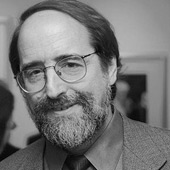Arts + Culture • Media • Music

March 3, 2005
The Aural As An Architectonic Challenge
I think of design in wider than simple visual, or visual-textual, or visual-spatial terms. Rarely, it seems, is the aural considered as an ongoing architectonic challenge, which is what the people over at Transom.org are up to. As it happens, this month is a very good time to pay them a visit: for the next several weeks, Walter Murch — the phenomenally smart and inspired film and sound editor — will be continuing to hold court there.
Transom.org is a project transpiring on the edge of public radio—or really, if we’re being honest with ourselves, beyond the edge. Conceived by a bunch of folks, many of them public radio veterans, who had become convinced that (and this is my characterization, not theirs) NPR was just getting too damn stodgy and set in its ways (and maybe impervious to fresh voices and new ways of story-telling and sound-delving), transom.org is a radically democratic experiment in widening aural horizons. Especially friendly to rank amateurs, the site features all the software tools a novice might need to begin editing his or her own programs, downloadable for free—and also provides a forum for sharing some of the resultant work with others. That work, and work as well by some of the most dynamic veteran producers in the field, is the sort of thing they, in turn, have trouble getting through some of the more conventionalizing filters at NPR Central. In addition, transom.org features a rotating roster of guest visitors — people like Errol Morris or Ira Glass or Alan Berliner or Brooke Gladstone or Kate Sullivan (of that terrific little show, “Pop Vultures”) — enthusiasts who start out by posting some sort of manifesto and then hang around for several weeks to explore its implications and convolutions with anyone else who chooses to drop by the site and kibbitz. (At the end of the residency, the resultant string of dialog is bound into a single Transom Review, and becomes downloadable as such.)
Which brings me back to Walter Murch, who is currently holding forth in one of the most jaw-droppingly fascinating performances I have yet stumbled upon on the net. Go see for yourself: Murch — the celebrated editor of such films as “The Conversation” and “Apocalypse Now” and “The English Patient” — as well as the author of both the classic discourse on film editing (In the Blink of an Eye) and, with Michael Ondaatje, The Conversations — is taking the occasion of his residency at transom.org to explore the ways that the mind processes sound. Of course it’s that and a whole lot more, including womb tone and dense clarity and an extraordinary deconstruction of the Valkyrie helicopter sequence from Lawrence Weschler is currently director of the New York Institute for the Humanities at NYU. He is the author of the books Boggs: A Comedy of Values, Robert Irwin: Getty Garden, and Vermeer in Bosnia: A Reader. He was featured in Volume 4, Issue 3 of The Transom Review.
Observed
View all
Observed
By Lawrence Weschler
Related Posts

Equity Observer
L’Oreal Thompson Payton|Essays
‘Misogynoir is a distraction’: Moya Bailey on why Kamala Harris (or any U.S. president) is not going to save us

Equity Observer
Ellen McGirt|Essays
I’m looking for a dad in finance

She the People
Aimee Allison|Audio
She the People with Aimee Allison, a new podcast from Design Observer

Equity Observer
Kevin Bethune|Essays
Oh My, AI
Related Posts

Equity Observer
L’Oreal Thompson Payton|Essays
‘Misogynoir is a distraction’: Moya Bailey on why Kamala Harris (or any U.S. president) is not going to save us

Equity Observer
Ellen McGirt|Essays
I’m looking for a dad in finance

She the People
Aimee Allison|Audio
She the People with Aimee Allison, a new podcast from Design Observer

Equity Observer
Kevin Bethune|Essays

 Lawrence Weschler, a staff writer at the New Yorker for over twenty years, is the director of the New York Institute for the Humanities at NYU. He is the author of
Lawrence Weschler, a staff writer at the New Yorker for over twenty years, is the director of the New York Institute for the Humanities at NYU. He is the author of